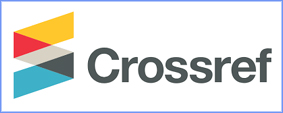EFEKTIFITAS KHITOSAN TERHADAP INTENSITAS SERANGAN Colletotrichum capsici PADA BUAH CABAI PASCAPANEN
Abstract
Effect of Chitosan to control Colletotrichum capsici on chili fruits in post harvest period was
investigated. Chitosan is an anti-fungi from crab or shrimp shells. Chitosan is a poly-cation polyglucosamine
(the one component of fungi cell wall). The author investigated Anthracnose disease
(%) and relative inhibition of anthracnose disease measured by scoring from AVRDC. Spraying
chitosan on chili fruit (harvesting time) covered the surface of chili from external factors including C.
capsici . Other research investigated that chitosan inhibited conidia germination, conidia
development and destroyed cell wall of hyphae of C. capsici. Chitosan layer on chili fruits surface
inhibited penetration process by C. capsici. Effect chitosan on relative inhibition of anthracnose
disease from all treatments of chitosan were significant with control (P≤ 0.05). Chitosan 0.75%
was the optimal concentration to inhibit anthracnose disease on chili fruits in post harvest period.
Chitosan is a physically barrier and an antifungal for C. capsici. Chitosane 0.75% inhibited
anthracnose disease 97.58%. The mechanism of chitosane may offer the better strategy in post
Full Text:
PDF (Bahasa Indonesia)References
Alexopoulus, C. J. and C. W. Mims.
Introductory
Mycology, John Willey
and Sons. New York.
AVRDC. 1996. Study on Chilli
Antrachnose. AVRDC
Progress Report 1996.
Asian Vegetables Research
and Development Center.
Taiwan. p. 27-30
Barka, E.A., P. Eullaffroy, C.
Clement and G. Vernet.
Chitosan Improves
Development, and Protect
Vitis vinifera L. Against
Botrytis cinerea. Plant Cell
Report. 22 (8):608-614.
Bautista-Banos, S., M. Hernandez-
Lopez, E. Bosquez-Molina
and C.L. Wilson. 2003.
Effect of Chitosan and
Plant Extract on Growth
of Colletotrichum
gloeosporioides, Anthracnose
Levels and Quality of
Papaya Fruit. Abstact. Plant
Protection. 22(9):1087-1092.
Benhamou, N. 1992. Ultrastructure
and Cytochemical Aspect
of Chitosan on Fusarium
Oxysporum f. sp. Radicis-
Lycopersici, Agent Of
Tomato Crown and Root
Rot. Phytopathology 82:
-1193.
Direktorat Bina Perlindungan
Tanaman. 1998.
Rekomendasi
Pengendalian Organisme
Pengganggu Tanaman
Hortikultura. Direktorat
Jenderal Tanaman
Pangan dan Hortikultura.
Departemen Pertanian.
Jakarta.59 hal.
Duriat, A. S. 1990. Budidaya dan
Usahatani Cabai (Capsicum
annum L.). Balai Penelitian
Tanaman Sayuran.
Lembang. 34p El
Ghaouth, A., J. Arul., J. Grenier and
A. Asselin. 1991. Potential
Use of Chitosan in
Postharvest Preservation
of Fruits and Vegetables in
Advance in Chitin and
Chitosan. Journal of Industial
Microbiology & Biotechnology.
(2):60-68.
El Ghaouth, A., J. Arul, C.L. Wilson,
N. Benhamou. 1997.
Biochemical and
Cytochemical Aspect of
the Interaction of Chitosan
and Botrytis cinerea in Bell
Chilli Fruit. Abstract.
Postharvest Biology &
Technology. 12 (2):183-194.
El Ghaouth, A., J. Arul, A. Asselin
and N. Benhamou. 1998.
Antifungal Activity of
Khitosan on Post Harvest
Pathogens. Induction of
Morphological and
Cytological Alterations in
Rhizopus stolonifer.
El Ghaouth, A. 2000. Aplication of
Candida saitonana and
Glycolchitosan for the
Control of Postharvest
Diseases of Apple and
Cytrus Fruit Under Semi-
Commercial Condition.
Abstract. Plants Disease.
:243-248
Mehrotra, R. S. 1980. Plant
Pathology. Tata Mc
Grow-Hill. New Delhi.
Pantastico, E. B. 1986. Fisiologi
Pascapanen: Penanganan
dan Pemanfaatan Buah–
buahan, sayuran Tropika
dan Subtropikan
(Diterjemahkan oleh
Kamariyani dan G.
Tjitrosoepomo). Gajah
Mada University Press.
Yogyakarta.
Romanazzi, G., A.Ippolito and F.
Nigro. 2003. Activity of
Glycol Chitosan on
Postharvest Strowbarry
Rot. Abstract. Postharvest
Biology and Technology. 31
(2). 61-69.
Sanford, P. A.,1989. Khitosan:
Commercial Uses and
Potential Application. In
Khitin and Khitosan.
Elsevier Applied Science.
London and New York.
Seo, H., K. Mitsuhashi and H.Tanibe.
antibacterial and
Antifungal Fiber Blanded
by Chitosan. In Advance in
Chitin and Chitosan.
Elsevier Applied Science.
London and New York.
DOI: https://doi.org/10.35194/agsci.v1i1.220
AGROSCIENCE INDEXED BY :
Fakultas Sains Terapan Universitas Suryakancana, Jl. Pasir Gede Raya-Cianjur, 43216, Telp. (0263) 283579, Email: agroscience@unsur.ac.id
Agroscience is licensed under a Creative Commons Attribution 4.0 International License.









